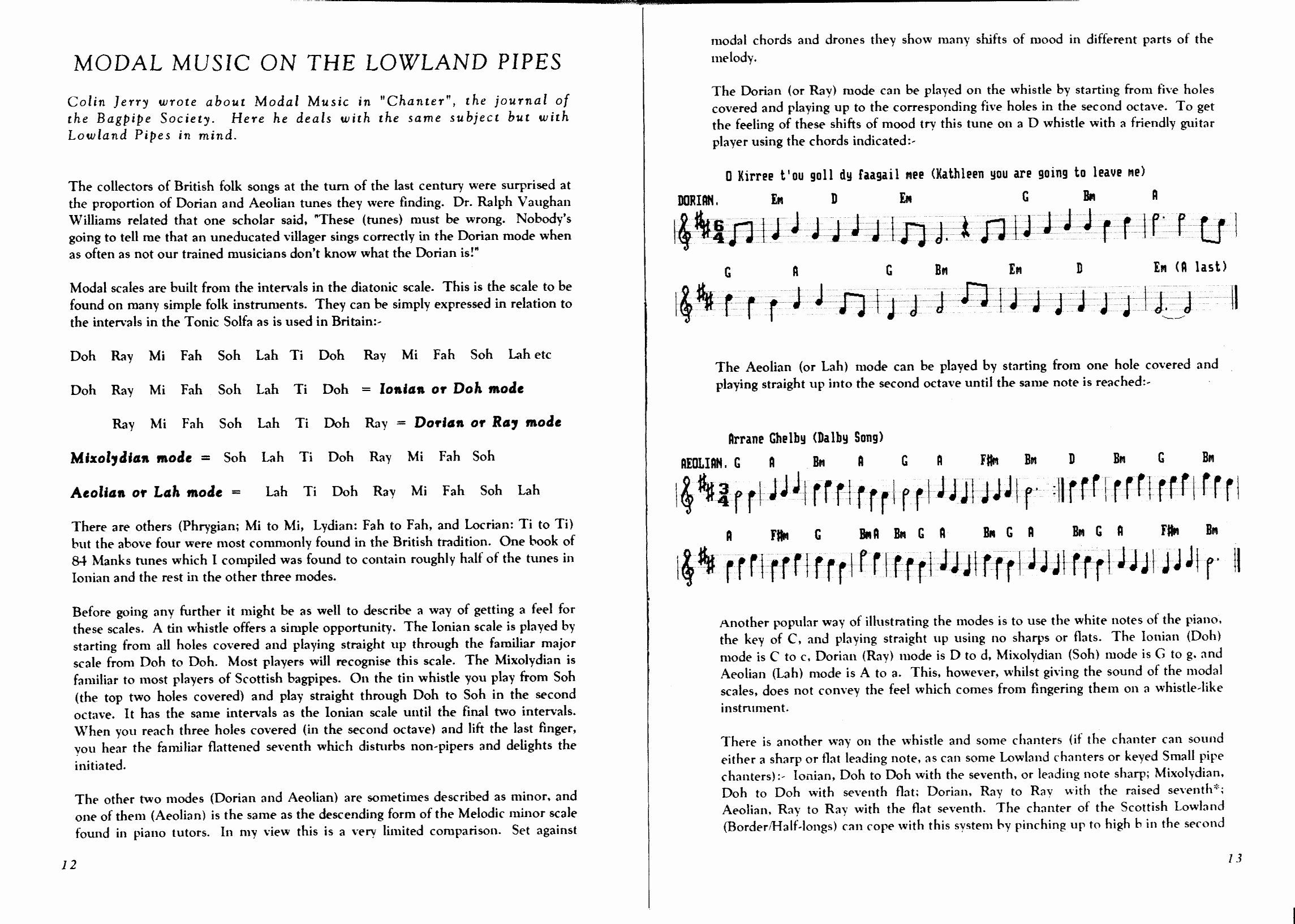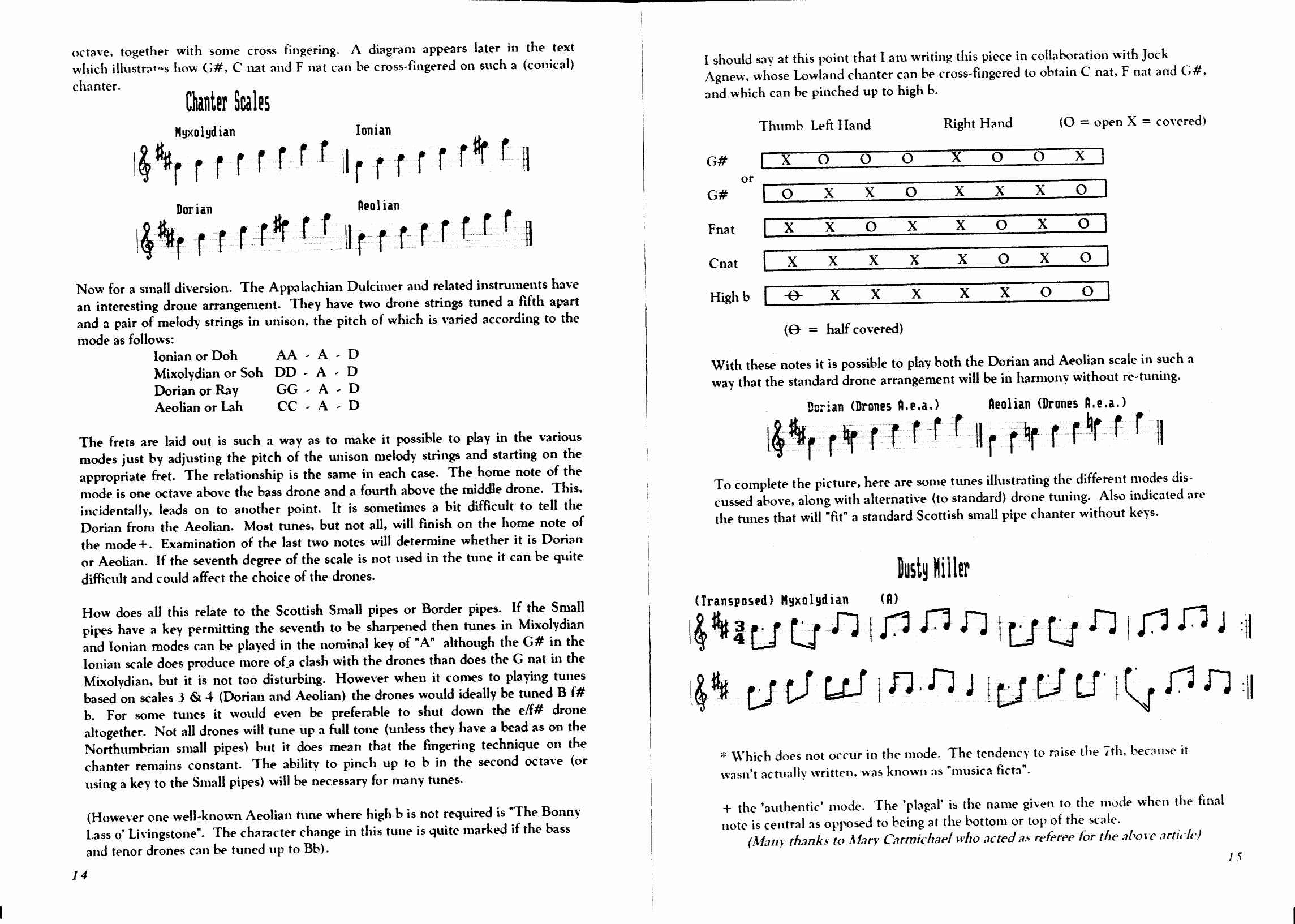Modal Music On The Lowland Pipes


<img src="/j3site/images/common-stock/files1 1984-1995/vol7no2dec92/vol7no2dec92_Page_9.png" alt="page 9" title="page 9"</p
Colin Jerry wrote about Modal Music in "Chanter", the journal of the Bagpipe Society. Here he deals with the same subject but with Lowland Pipes in mind.
The collectors of British folk songs at the turn of the last century were surprised at the proportion of Dorian and Aeolian tunes they were finding. Dr. Ralph Vaughan Williams related that one scholar said, "These (tunes) must be wrong. Nobody’s going to tell me that an uneducated villager sings correctly in the Dorian mode when as often as not our trained musicians don’t know what the Dorian is!”
Modal scales are built from the intervals in the diatonic scale. This is the scale to be found on many simple folk instruments. They can be simply expressed in relation to the intervals in the Tonic Solfa as is used in Britain:-
Doh Ray Mi Fah Soh Lah Ti Doh Ray Mi Fah Soh Lah etc
Doh Ray Mi Fah Soh Lah Ti Doh = Ionian or Doh mode
Ray Mi Fah Soh Lah Ti Doh Ray = Dorian or Ray mode
Mixolydian mode = Soh Lah Ti Doh Ray Mi Fah Soh
Aeolian or Lah mode = Lah Ti Doh Ray Mi Fah Soh Lah
There are others (Phrygian; Mi to Mi, Lydian: Fah to Fah, and Locrian: Ti to Ti) but the above four were most commonly found in the British tradition. One book of 84 Manks tunes which I compiled was found to contain roughly half of the tunes in Ionian and the rest in the other three modes.
Before going any further it might be as well to describe a way of getting a feel for these scales. A tin whistle offers a simple opportunity. The Ionian scale is played by starting from all holes covered and playing straight up through the familiar major scale from Doh to Doh. Most players will recognise this scale. The Mixolydian is familiar to most players of Scottish bagpipes. On the tin whistle you play from Soh (the top two holes covered) and play straight through Doh to Soh in the second octave. It has the same intervals as the Ionian scale until the final two intervals. When you reach three holes covered (in the second octave) and lift the last finger, you hear the familiar flattened seventh which disturbs nonpipers and delights the initiated.
The other two modes (Dorian and Aeolian) are sometimes described as minor, and one of them (Aeolian) is the same as the descending form of the Melodic minor scale found in piano tutors. In my view this is a very limited comparison. Set against modal chords and drones they show many shifts of mood in different parts of the melody.
The Dorian (or Ray) mode can be played on the whistle by starting from five holes covered and playing up to the corresponding five holes in the second octave. To get the feeling of these shifts of mood try this tune on a D whistle with a friendly guitar player using the chords indicated:-

The Aeolian (or Lah) mode can be played by starting from one hole covered and playing straight up into the second octave until the same note is reached:-

Another popular way of illustrating the modes is to use the white notes of the piano, the key of C, and playing straight up using no sharps or flats. The lonian (Doh) mode is C to c, Dorian (Ray) mode is D to d, Mixolydian (Soh) mode is G to g, and Aeolian (Lah) mode is A to a. This, however, whilst giving the sound of the modal scales, does not convey the feel which comes from fingering them on a whistle-like instrument.
There is another way on the whistle and some chanters (if the chanter can sound either a sharp or flat leading note, as can some Lowland chanters or keyed Small pipe chanters):- Ionian, Doh to Doh with the seventh, or leading note sharp; Mixolydian, Doh to Doh with seventh flat; Dorian, Ray to Ray with the raised seventh*; Aeolian. Ray to Ray with the flat seventh. The chanter of the Scottish Lowland (Border/Half-longs) can cope with this system by pinching up to high b in the second octave, together with some cross fingering. A diagram appears later in the text which illustrates how G#, C nat and F nat can be crossfingered on such a (conical) chanter.

Now for a stnall diversion. The Appalachian Dulcimer and related instruments have an interesting drone arrangement. They have two drone strings tuned a fifth apart and a pair of melody strings in unison, the pitch of which is varied according to the mode as follows:
Ionian or Doh AA -A- D
Mixolydian or Soh DD - A - D
Dorian or Ray GG -A- D
Aeolian or Lah cc -A- D
The frets are laid out is such a way as to make it possible to play in the various modes just by adjusting the pitch of the unison melody strings and starting on the appropriate fret. The relationship is the same in each case. The home note of the mode is one octave above the bass drone and a fourth above the middle drone. This, incidentally, leads on to another point. It is sometimes a bit difficult to tell the Dorian from the Aeolian. Most tunes, but not all, will finish on the home note of the mode +. Examination of the last two notes will determine whether it is Dorian or Aeolian. If the seventh degree of the scale is not used in the tune it can be quite difficult and could affect the choice of the drones.
How does all this relate to the Scottish Small pipes or Border pipes? If the Small pipes have a key permitting the seventh to be sharpened then tunes in Mixolydian and Ionian modes can be played in the nominal key of "A" although the G# in the Ionian scale does produce more of a clash with the drones than does the G nat in the Mixolydian, but it is not too disturbing. However when it comes to playing tunes based on scales 3 & 4+ (Dorian and Aeolian) the drones would ideally be tuned B f# b. For some tunes it would even be preferable to shut down the e/f# drone altogether. Not all drones will tune up a full tone (unless they have a bead as on the Northumbrian small pipes) but it does mean that the fingering technique on the chanter remains constant. The ability to pinch up to b in the second octave (or using a key to the Small pipes) will be necessary for many tunes.
(However one well-known Aeolian tune where high b is not required is "The Bonny Lass O’ Livingstone’. The character change in this tune is quite marked if the bass and tenor drones can be tuned up to Bb).
I should say at this point that 1 am writing this piece in collaboration with Jock Agnew, whose Lowland chanter can be cross-fingered to obtain C nat, F nat and G#, and which can be pinched up to high b.

With these notes it is possible to play both the Dorian and Aeolian scale in such a way that the standard drone arrangement will be in harmony without re-tuning.

To complete the picture, here are some tunes illustrating the different modes discussed above, along with alternative (to standard) drone tuning. Also indicated are the tunes that will "fit" a standard Scottish small pipe chanter without keys.

* Which does not occur in the mode. The tendency to raise the 7th, because it wasn’t actually written, was known as "musica ficta”.
+ the ‘authentic’ mode. The 'plagal’ is the name given to the mode when the final note is central as opposed to being at the bottom or top of the scale.
(Many thanks to Mary Carmichael who acted as referee for the above article)



